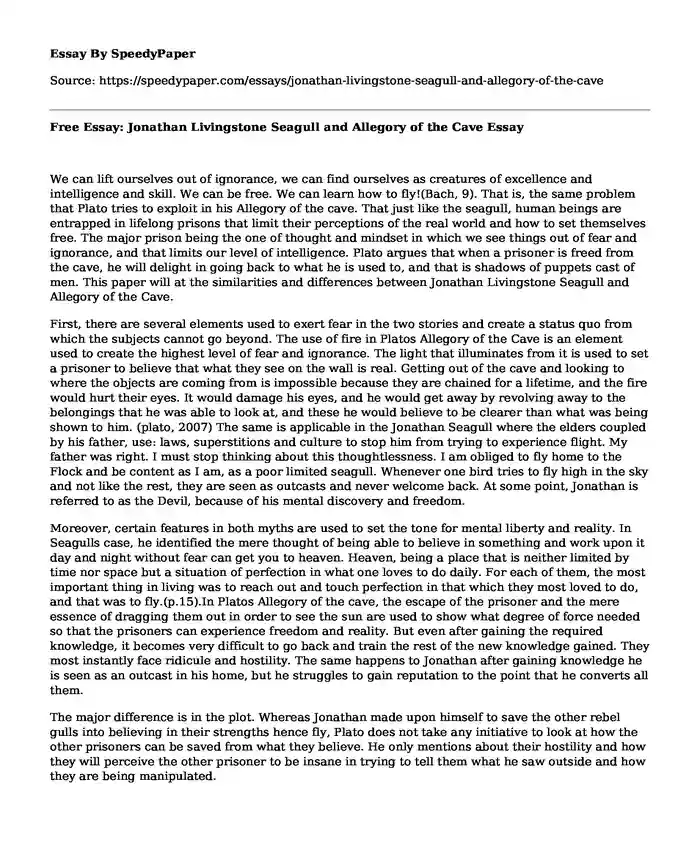
| Type of paper: | Essay |
| Categories: | Literature Philosophy Allegory of the Cave Plato |
| Pages: | 3 |
| Wordcount: | 817 words |
We can lift ourselves out of ignorance, we can find ourselves as creatures of excellence and intelligence and skill. We can be free. We can learn how to fly!(Bach, 9). That is, the same problem that Plato tries to exploit in his Allegory of the cave. That just like the seagull, human beings are entrapped in lifelong prisons that limit their perceptions of the real world and how to set themselves free. The major prison being the one of thought and mindset in which we see things out of fear and ignorance, and that limits our level of intelligence. Plato argues that when a prisoner is freed from the cave, he will delight in going back to what he is used to, and that is shadows of puppets cast of men. This paper will at the similarities and differences between Jonathan Livingstone Seagull and Allegory of the Cave.
First, there are several elements used to exert fear in the two stories and create a status quo from which the subjects cannot go beyond. The use of fire in Platos Allegory of the Cave is an element used to create the highest level of fear and ignorance. The light that illuminates from it is used to set a prisoner to believe that what they see on the wall is real. Getting out of the cave and looking to where the objects are coming from is impossible because they are chained for a lifetime, and the fire would hurt their eyes. It would damage his eyes, and he would get away by revolving away to the belongings that he was able to look at, and these he would believe to be clearer than what was being shown to him. (plato, 2007) The same is applicable in the Jonathan Seagull where the elders coupled by his father, use: laws, superstitions and culture to stop him from trying to experience flight. My father was right. I must stop thinking about this thoughtlessness. I am obliged to fly home to the Flock and be content as I am, as a poor limited seagull. Whenever one bird tries to fly high in the sky and not like the rest, they are seen as outcasts and never welcome back. At some point, Jonathan is referred to as the Devil, because of his mental discovery and freedom.
Moreover, certain features in both myths are used to set the tone for mental liberty and reality. In Seagulls case, he identified the mere thought of being able to believe in something and work upon it day and night without fear can get you to heaven. Heaven, being a place that is neither limited by time nor space but a situation of perfection in what one loves to do daily. For each of them, the most important thing in living was to reach out and touch perfection in that which they most loved to do, and that was to fly.(p.15).In Platos Allegory of the cave, the escape of the prisoner and the mere essence of dragging them out in order to see the sun are used to show what degree of force needed so that the prisoners can experience freedom and reality. But even after gaining the required knowledge, it becomes very difficult to go back and train the rest of the new knowledge gained. They most instantly face ridicule and hostility. The same happens to Jonathan after gaining knowledge he is seen as an outcast in his home, but he struggles to gain reputation to the point that he converts all them.
The major difference is in the plot. Whereas Jonathan made upon himself to save the other rebel gulls into believing in their strengths hence fly, Plato does not take any initiative to look at how the other prisoners can be saved from what they believe. He only mentions about their hostility and how they will perceive the other prisoner to be insane in trying to tell them what he saw outside and how they are being manipulated.
To conclude, it is significant to identify the similarities and difference between the two myths. Plato identifies with a cave where humans are chained for a lifetime. Metaphorical, Plato forces the idea that humans fail to gain change quickly from a political and religious perspective. They will continue to believe in illusions and lies presented to them by their leaders who use puppets, fire and cave (laws, superstitions and jail respectively) to manipulate them for the personal gain. The same applies to Seagull, where fears and legislation and wars limit the flocks thought of mental freedom to be able to fly high in life. Nothing is for sure right, but all are subject to practice and belief.
Works Cited
Bach, R. Jonathan Livingstone Seagull.London: Turnstone Press, 1970. Print.
Plato. The Allegory of the Cave. Retrieved from http://faculty.washington.edu/smcohen/320/cave.htm (15th Sept 2015)
Cite this page
Free Essay: Jonathan Livingstone Seagull and Allegory of the Cave. (2020, Apr 28). Retrieved from https://speedypaper.com/essays/jonathan-livingstone-seagull-and-allegory-of-the-cave
Request Removal
If you are the original author of this essay and no longer wish to have it published on the SpeedyPaper website, please click below to request its removal:
- Free Literary Essay on Sei Shonagon's The Pillow Book
- What Is Social Power Essay Example
- Free Essay on the Background of Punishment in the United States
- Essay Sample about Samantha Parks, the CEO and Owner of the Sparks Company
- Free Essay: How Temperature Determines Sex in Reptiles and the Consequences of This Mode of Sex
- Wellness Theory Essay Example
- Paper Example. Women in Leadership Positions
Popular categories




